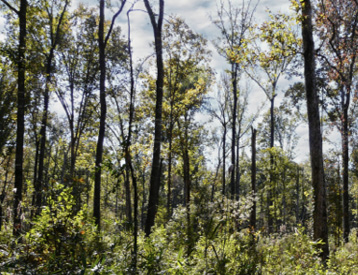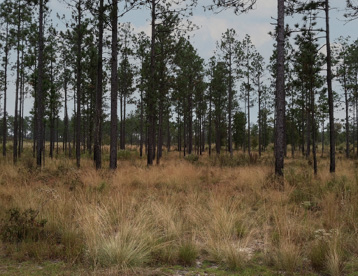Attract More Wildlife Through Timber Management
Mississippi’s 19.8 million acres of forestland are valuable and produce many renewable benefits, including timber, recreational opportunities, watershed and erosion protection, and wildlife habitat. Unfortunately, many landowners are unaware of the many benefits forestlands can provide.
For example, many people believe that unmanaged, natural forests are best for game. Consequently, the average acre of Mississippi forestland produces less than its potential in both timber and wildlife habitat. Properly managed forests can not only yield greater amounts of wood products but also provide high-quality habitat for many of the state’s wildlife species.
Timber and wildlife management are not mutually exclusive. Often, as a result of more diverse timber and wildlife management programs, today’s landowners receive additional income from recreational leases and other so-called non-forestry ventures. Supplemental income from this practice can be significant and is often used to pay for items such as property tax liability.
Where to Start
A common reason for leaving forestland unmanaged is that landowners believe forest management is too expensive. This is simply not the case if you plan well and make cost-conscious decisions. Prioritize your management objectives by timber stand. A property may have multiple stands with a variety of management objectives depending on stand characteristics or goals for wildlife management. For example, the primary objective for one stand could be timber, and the objective for another might be quail habitat.
Professional help is as near as your telephone and is often free. Many agencies, such as the Mississippi Forestry Commission and the Mississippi Department of Wildlife, Fisheries, and Parks, provide free services to help you identify your management goals and plan activities to reach those goals. Private consultants offer similar services. In this phase, you will write a management plan that states your goals for the property and a schedule of management practices you will use to help meet them.
When implementing the plan, you can adjust practices to meet your goals and budget. For example, if turkeys are a management objective, you will need to provide proper habitat for nesting and brood-rearing. This can be done by harvesting small areas, thinning, making fire lanes and access roads, or improving and maintaining existing forest openings.
Wildlife Needs
Many of Mississippi’s wildlife species depend on the forest to live. Some, such as deer, turkeys, and squirrels, spend most of their lives in the forest. All wildlife have four basic needs: food, water, space, and cover. Generally speaking, wildlife will prosper in areas with multiple habitat types. A diverse forest habitat combines different timber types, age classes, and stand conditions in one area.
Often only minor efforts are needed to manipulate habitat so that it becomes more attractive to your target wildlife species. Even-aged timber management can provide diversity by locating different age stands close to one another. For example, research has shown that properly managed clear-cut areas close to young and mature pine timber stands can provide excellent quail and deer habitat for several years.
Additionally, when developing a wildlife management program, it is important to look closely at nearby properties and consider how they will influence your wildlife program. This is a key element of forest stewardship and is especially important when managing small ownerships. For example, instead of creating openings in a small forest next to an existing opening, the space might be better used to implement some other practice that helps you reach your overall management goals.
Management Techniques
For many years, foresters and wildlife managers have acknowledged the value of forest openings for wildlife. Timber harvesting creates openings that may be large or small. Other disturbances, such as prescribed burning and herbicide application, can greatly improve wildlife habitat for many species while benefiting timber production. Combining appropriate forest management techniques into your management plan can prove beneficial to both wildlife and timber.
Cutting Methods for Regeneration
Regeneration cutting is performed by removing trees from an area to allow regeneration of a new forest. In clear-cutting, all trees are harvested at the same time, whereas in seed tree and shelterwood harvests, high-quality trees are left and used to regenerate the forest naturally (Figure 1). Once desirable regeneration is obtained, the remaining overstory trees are removed so that the newly regenerated forest can grow. These cutting techniques are used to harvest marketable timber and to create the best environment for young trees to establish and grow.
Following a harvest, many shade-intolerant plants begin to grow in openings. Wildlife often prefer the highly palatable and nutritious plant species that arise in these settings. Additionally, due to increased light and nutrient availability in these openings, these plants often provide comparably greater quantities of available fruit and seed for food.
Many landowners are concerned with the negative impacts of harvests on wildlife. However, negative effects can be reduced by considering the size, shape, and distribution of harvested areas in your harvest plan. Small (20 to 100 acres), irregularly shaped cuts next to larger stands of different ages will provide diverse habitat preferred by many wildlife species. You can use these methods to regenerate pine and hardwood stands.
Improvement Cuttings
During the natural development of a forest, young trees compete for space, light, water, and nutrients. Some species, and individual stems of a given species, will outcompete others and become dominant in the forest. Dominant trees in even-aged forests are typically large and fast-growing.
The purpose of improvement cuttings (including, but not limited to, thinnings) is to remove trees of species undesirable to your management goals, trees that are damaged or unhealthy, trees that are of low quality, or trees that you do not think will survive until the next cutting. Foresters use improvement cuttings to improve the overall quality of a forest. Such harvesting creates space for crop trees to grow and allows more sunlight to reach the forest floor. This light aids the growth of many low-growing plants valuable for wildlife.
However, these benefits are short-lived. In a few years, the forest canopy will close again and shade out most of the forage plants established post-harvest. Improvement cuts can be made later to help wildlife and increase the stand’s timber value.
Some wildlife species need cavity trees for nesting and shelter. Therefore, when implementing an improvement cut, try to keep several good cavity trees per acre. Cavity trees should be selected based on the presence of an existing cavity large enough to be used by wildlife species of interest. Often, cavity trees are food-producing species, such as oak, hickory, blackgum, beech, or bald cypress. These are useful to many wildlife species, and leaving them does not result in a significant decrease in timber production.
Prescribed Burning
Prescribed burning is a practice used to accomplish management objectives for a stand. Fire promotes an early successional stage in the understory of a timber stand (Figures 2 and 3). Periodic use of prescribed fire can maintain these early successional stages and help provide ample cover and forage for wildlife.
Burn frequency depends on the species of wildlife you are attempting to attract. For example, when managing pines to maximize the potential for quail, you may want to burn more frequently than if managing for deer. Think about what your target wildlife feeds on, as well as its preferred cover type. In the case of quail, you are trying to produce as many seeds and insects as possible while maintaining cover approximately 2 feet high. Conversely, deer would have difficulty finding sufficient cover in optimal quail habitat and would prefer more herbaceous or woody vegetation.
As previously discussed, it is often better to have a diversity of cover types and forage on your property. This can be achieved using a burn rotation. A burn rotation is simply a schedule for burning a portion of your property on a yearly, or multi-year, basis. Rotating burning time on different portions of your property allows for a variety of different successional stages at all times (Figure 4). This system yields a more diverse habitat and lowers the workload for managers compared to burning the entire property every year.
Early successional plants promoted through prescribed fire have the same essential needs as your timber stand. If desired understory species are not obtained in the year following a burn, you may need to perform a thinning operation. Removing selected stems in the stand will allow more light, water, and nutrients for the understory. Other advantages of a properly conducted burn include wildfire fuel reduction, woody and herbaceous competition control, and improved visibility and accessibility.
Prescribed burning can be a valuable tool for forest and wildlife management, but it must be used properly. Contact your local Extension agent, Extension forestry specialist, or a registered forester to help locate a certified prescribed-burn manager in your area. He or she can create a written burn plan specific to your property and management objectives and will obtain the required burn permit before performing the burn. This burn manager and plan must be on-site the day of the burn to ensure that it is carried out per plan instructions and for liability purposes.





Forest Herbicides
Forest herbicides are a valuable forest management tool. Today’s herbicides are safe and economical to use in a forest management program. They are used in site preparation, stand improvement, vegetation control, and wildlife habitat improvement. Herbicides are used in pine and hardwood timber management.
Compounds have been developed that can be applied over the top of pines and hardwoods to control competing vegetation without harm to crop trees. Additionally, herbicide applications can be tailored to management objectives and help obtain more desirable herbaceous species at ground level. For example, when used with prescribed burnings, herbicides containing imazapyr can be used to selectively control less nutritious vegetation on the forest floor while leaving more palatable legumes for wildlife use (Figure 5).
Firebreaks and Access Roads
The foundation of a good forest management plan is an adequate network of firebreaks and access roads. Foresters may recommend these to landowners for forest protection. However, their role is twofold because fire lanes and roads also are important areas for wildlife.
Turkey, quail, and other wildlife often use fire lanes and roads for feeding, nesting, and brood-rearing. Deer can be attracted to them for food and may use them for traveling. Establishing favorite wildlife foods, such as grasses and forbs, in fire lanes and along roadsides will improve wildlife benefits.
An Example
Mr. Anderson has 85 acres of forestland inherited from his grandfather. He wants to make some income from the timber but doesn’t want to clear-cut his property for fear of ruining his hunting opportunities. Turkey and white-tailed deer are his preferred species, but squirrel hunting is important, too.
His property has a 20-acre stand of young hardwood sawtimber along a stream and 45 acres of 25-year-old oak-pine timber. The remaining 20 acres is a 15-year-old pine plantation that has never been managed.
Mr. Anderson consulted a forester and developed a management plan to establish a few roads and firebreaks to provide access and fire protection for his property. These will also serve as wildlife openings and as a food source for deer and rabbits.
An improvement cut in the hardwood stand favoring oaks will increase acorn production, and oak crop trees will increase in size and value. He will take care to mark and leave several cavity trees per acre for gray squirrels.
He plans to thin the pine plantation so more valuable trees will have space for further development. After thinning, he will use prescribed burning every third year to maintain deer and turkey habitat. Prescribed burning will be performed in late winter (February or March) to avoid turkey-nesting season. He also plans to thin his plantation again when practical, probably 6 to 8 years after the first thinning.
Mr. Anderson decided to manage the oak-pine stand for pine timber production. However, on 1 acre near the pine plantation, he decided to keep some large oak and hickory trees as another wildlife food source.
The remaining oak-pine stand needed an improvement cut to remove inferior hardwoods and pines. After the harvest, he will use prescribed burning, except in the wildlife food area previously marked.
As a result of his management strategy, Mr. Anderson will receive extra income from his forestland and can expect greater profits from future harvests. The forest he has created will increase in value each year while simultaneously providing high-quality habitat for multiple species of wildlife.
Forest management improves the forest environment for people, animals, and trees. Your forestland is valuable for the wildlife, timber, and other products and benefits produced there. Forest management can add to your pleasure and satisfaction of forest ownership while increasing revenue.
Forestry Terminology
Some of the technical terms used in this publication may be unfamiliar. If you have any questions regarding their use, please consult Mississippi State University Extension Publication 1250 Forestry Terms for Mississippi Landowners.
Contacts
Mississippi Forestry Commission
Mississippi Department of Wildlife, Fisheries, and Parks
Mississippi State University Extension: Contact your county Extension agent or an Extension forestry specialist.
Natural Resources Conservation Service: Find your district conservationist in the phone book or online.
Mississippi Board of Registration for Foresters (roster available): P.O. Box 1884, Jackson, MS 39215
Publication 1446 (POD-02-24)
Revised by A. Brady Self, PhD, Associate Extension Professor, Forestry, from an earlier edition by Robert Daniels, Extension Professor (retired), and James Miller, Extension Outreach Research Scientist (retired). Photos by A. Brady Self.
The Mississippi State University Extension Service is working to ensure all web content is accessible to all users. If you need assistance accessing any of our content, please email the webteam or call 662-325-2262.







